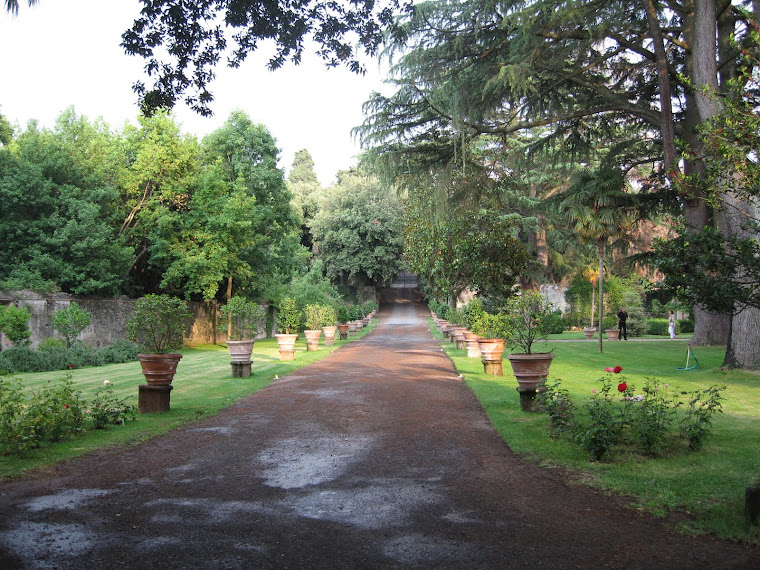
I can say with certainty that I had one of the most interesting days of my life exploring the Jewish quarter with Mark, my husband of 25 years and Alex, our guide.
On the way to the former Jewish quarter, Alex pointed out a memorial in front of the Berlin Symphony Orchestra House, which was erected to commemorate Hitler's plan to rid the Aryans of mentally and physically challenged people, called the T 4 plan. It is two S shaped granite columns. The memorial is perfect and symmetrical in design and is a nice way to pay homage to people who are imperfect.
In the former Jewish section, there are small gold (or perhaps brass?) plaques, placed discreetly in the sidewalk in front of individual homes. I thought this was such a meaningful way to remember the Jewish people, whose name, date of birth and where and when they were murdered, is inscribed on each plaque. Alex waited for one of us, and it happened to be Mark, to stumble on the first plaque. I thought the significance of this was that people carried on their lives in Berlin hardly noticing that their Jewish neighbours were disappearing from around them. Of course once we saw the first plaque, then we started to see the others.
I particularly liked hearing about how the women of Rosenstrazse protested when their husbands were imprisoned. The memorial is on the sight of the Old Synagogue, which was destroyed on Kristallnacht. The stones show the women pleading for their husbands' lives. Four weeks later the men were released.
We also visited Otto Weitz's workshop where he sheltered Jews in his workshop for the blind. They made brushes, which were in demand during the war. Otto Weitz personally went to rescue his Jewish secretary from Auschwitz. He successfully arranged for her escape.
I thought it was so neat the way the whole area has become a hip artist's area, full of boutiques and cheap former East Bloc housing for hippies. Berlin is a thriving living memorial to the dead. It is also a good tourist trap as I saw some interesting fashion by avant garde designers.
I am now consumed by wanting to read Holocaust literature. I took several pamphlets from Otto Weitz's shop. As well, Mark bought an excellent book at Terezienstadt by a survivor.

We stopped for a pastry. Mark to provide details. Alex told us that the owner made bread for the deportation camps as well as challah on Friday nights. The bakery also survived during communism. The bakery is still owned by the daughter, now in her eighties, of the original owner.

Alex also showed us the New Synagogue. Miraculously it was not destroyed on Kristallnacht. A policeman, Krutzfeld, warned the caretaker of the impending pogrom. The son of the caretaker, who survived the war, revealed this later. The Nazis used the synagogue to store their records of who was Jewish, half Jewish etc. They remain because the Nazis filled in the ceiling of the shul with rubble so that if it was bombed the rubble would stop the total destruction. They also threw some artifacts into the ceiling, like the Aron Kodesh which we saw.

We ended our day at the wonderful Jewish Museum. Libeskind's architecture is so thoughtful and I particularly liked his depiction of emigration from Berlin by having the visitor walk through the pathways of columns, which are built on a slope. Thus creating the feeling of losing one's footing in a new country. The museum is not a Holocaust museum. It focuses on German Jewish life from medieval times to the present day collapse of the wall and the current social political life of German Jewry. It is more about education and understanding. I think non-Jews would find it particularly enlightening.
There is a tower depicting the Holocaust. The visitor stands in the enclosed space in near darkness.
In our tours in general of Berlin, Alex keeps pointing out evidence of the wall. We saw today a huge area of grass which was a no man's land. Yesterday we saw how this no man's land was turned into a beach along the Spree river. Because the wall only came down in 1988, Berlin is full of exciting new buildings and the architecture is very futuristic. Potsdam Square (Potsdamer Platz) and the fabulous Mis van Der Roe National Art Gallery are examples of this. In contrast some of the former Eastern Bloc housing still stands.
At the end of a tiring and interesting day, we found a delightful local restaurant where we ate an Italian meal with people who obviously live in the neighbourhood and were stopping by after work with their wives or friends for a simple meal. I was reading one of the pamphlets I had taken today, but found myself hiding the title about Jewish Resistance during the war.

No comments:
Post a Comment